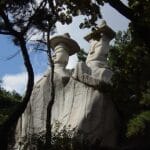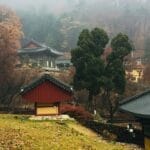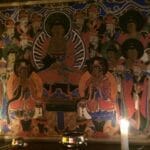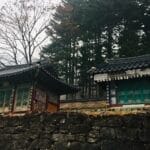by Hugo J. Smal
images: Mickey Paulssen
Back to Bogwangsa
Years ago, I first visited Bogwangsa Temple. Back then, I even climbed up to the large statue of Jijang-bosal. Today, his distant gaze is enough to greet me. I also visited the Yongmi-ri Maaebul at that time—two stone-carved Buddha statues high up on the mountainside. They are said to protect the land, especially the royal family.

These figures are known as the “Two Standing Rock Buddhas of Yongmi-ri” (용미리 마애이불입상). Designated as Korean Treasure No. 93, they are considered significant examples of Goryeo dynasty Buddhist art. Their small stone hats are designed to shield them from the rain.
Legend of the Princess and the Monks at Bogwangsa Temple
According to a Goryeo-era tradition (918–1392), there once was a royal princess who could not bear children. One night, two enlightened monks appeared to her in a dream and said:
“We live among the rocks on the southern slope of Mount Jangjisan. We are hungry. Please feed us.”
Goryeo Dynasty Overview
The princess told her dream to the king, who dispatched attendants to the location mentioned. There, they found two large rocks standing side by side. Suddenly, the monks appeared again and instructed the men to carve statues from the stones. From the left rock, Mireuk-bul—the Buddha of the Future—was carved. From the right, Mireuk-bosal—the Bodhisattva of the Future. A little boy Dongja is standing between them.
The monks promised that anyone who prayed to these images would have their wishes granted, especially those seeking children or healing. After the statues were completed, a temple was built at the site. That same year, Prince Hansan was born.
Royal Dedication: King Sejo and Queen Jeonghui at Bogwangsa Temple
In 1995, inscriptions were discovered on the stone-carved figures at Yongmi-ri, dating back to 1471 during the Joseon dynasty. These inscriptions suggest that the statues were created in honor of King Sejo (r. 1455–1468) and his consort, Queen Jeonghui. According to this interpretation, the left figure with the round hat represents King Sejo as Mireuk-bul (the Buddha of the Future), while the right figure with the square hat represents Queen Jeonghui as Mireuk-bosal (the Bodhisattva of the Future).
One of the inscriptions reads:
“In the future, the great saint Mireuk-bul, Great King Sejo, will be reborn in the Pure Land.”
Although this theory remains unconfirmed, it highlights the profound spiritual and royal significance of these Buddhist statues.
The Shadow of Gounsa Temple: A Spiritual Loss for Korean Buddhism

While writing about Bogwangsa Temple, I received heartbreaking news: the centuries-old Gounsa Temple in Gyeongsangbuk-do had been largely destroyed by fire. Founded in 681 by the eminent monk Uisang—a fellow traveler of Wonhyo and founder of the Korean Hwaeom school—Gounsa belonged to the Jogye Order and was revered for its profound silence, spiritual discipline, and an imposing gilded Buddha statue that proved too heavy to rescue.
The loss was far more than physical. For Korean Buddhism, it marked a spiritual wound—a break in a lineage that had been cherished for centuries through prayer and devotion.
Bodhisattva Francis: A Buddhist Tribute to the Pope in Korea
 Around the same time, I was deeply moved by the death of Pope Francis. The Jogye Order, Korea’s largest Buddhist monastic order, released an official statement. Venerable Jinwoo, its leader, expressed condolences and described the Pope as a “true compassionate bodhisattva.” He praised the Pope’s dedication to vulnerable groups and his respect for other religions. Jinwoo also recalled the Pope’s historic 2014 visit to South Korea, during which he sought spiritual connection with leaders of the Jogye Order and other faiths.
Around the same time, I was deeply moved by the death of Pope Francis. The Jogye Order, Korea’s largest Buddhist monastic order, released an official statement. Venerable Jinwoo, its leader, expressed condolences and described the Pope as a “true compassionate bodhisattva.” He praised the Pope’s dedication to vulnerable groups and his respect for other religions. Jinwoo also recalled the Pope’s historic 2014 visit to South Korea, during which he sought spiritual connection with leaders of the Jogye Order and other faiths.
Coincidence, perhaps—but it felt like more. While violence continued in Gaza and Ukraine, Korea lost a spiritual monument. And while world leaders like Putin, Trump, and Xi Jinping played games of ego and power, a true follower of Francis of Assisi departed this world.
Francis of Assisi (1181/82–1226), the Italian Catholic saint and founder of the Franciscan Order, was renowned for his radical poverty, love of nature, and deep compassion for all living beings. He saw God in everything and everyone, preached peace, humility, and simplicity, and became the patron saint of animals and the environment. His influence transcends religious boundaries and continues to inspire spiritual seekers around the world.
Sacred Juniper Tree at Bogwangsa Temple: A Royal Memorial

An ancient juniper tree sways solemnly in the rain. According to local tradition, the tree was planted by King Yeongjo of the Joseon dynasty (r. 1724–1776) in memory of his mother, Sukbin Choe, a royal concubine of King Sukjong. The tree stands beside Eosil-gak Hall, a memorial space that enshrines the spirit tablet of Sukbin Choe.
In Korean culture, such a tree symbolizes the connection between heaven and earth. It acts as a bridge between the spiritual and the material realms. The presence of this tree enhances the sacred atmosphere of the temple and reminds visitors of the deep spiritual traditions that are revered here.
Yeonggakjeon Memorial Hall at Bogwangsa Temple

At Bogwangsa Temple, the memorial space where small Buddha statues are enshrined is called Yeonggakjeon (영각전). This hall is dedicated to the deceased and serves as a sacred place for prayers and ceremonies for their souls. Visitors place small Buddha statues with name plaques to honor loved ones and accumulate spiritual merit.
The illuminated statues symbolize wisdom, enlightenment, and the presence of Buddha. The unlit golden Buddhas on the right side likely serve as personal or family memorials. Donating such a statue is considered an act of compassion—a source of merit and spiritual blessing.
Although such halls are often named Jijang-jeon (지장전), in reference to Jijang-bosal (Ksitigarbha), the protector of souls in the afterlife, this space at Bogwangsa specifically bears the name Yeonggakjeon.
Chilseongak and the Seven-Star Ritual in Korean Temple Tradition

Depiction of the Seven Stars (Chilseong), celestial guardians of fate and longevity, central to rituals for protection and cosmic harmony.
The Chilseongjae is a ritual dedicated to the Seven Stars (Chilseong, 칠성), celestial beings that hold deep symbolic meaning in Korean Buddhist and folk tradition. In Korean cosmology, the Seven Stars represent:
Longevity and health
Wisdom and spiritual protection
Karma and destiny
Leadership and cosmic order
In temple paintings, Chilseong is often depicted as seven celestial kings beneath a starry sky. Surrounding scenes illustrate prayer, transition, purification, and rebirth. This Chilseongak is really a beauty of Korean Buddhist art. For me, these Seven Stars are inseparably linked to the Jijang Fractal—a spiritual structure of interconnection, transformation, and inner truth.
Bulhwa and the Jijang Taenghwa: Visual Dharma in Yeonggakjeon

Inside the Yeonggakjeon, a sacred painting known as a Taenghwa (hanging scroll) depicts Jijang-bosal (지장보살, Ksitigarbha), the bodhisattva who vows to save beings from hell. Flanking him on the left and right are likely celestial kings or spiritual guardians. Below them appear officials and warriors, most likely the Siwang, the Ten Kings of the Underworld, who preside over the fates of the dead.
The use of red and blue colors in the painting symbolizes vital energy and purification. The space is adorned with glowing lotus lanterns, each bearing a name tag dedicated to a deceased loved one—offering light, remembrance, and spiritual merit.
Beyond the Fractal: A Dream of Silence with Jijang and Avalokiteśvara
Sitting before the Jijang Taenghwa, lost in reflection, I recalled another dream:
A veil of mist cloaked the mountain’s peak. Jijang-bosal and Avalokiteśvara stood side by side.
There were no calculations. No formulas. No fractals.
Only breath.
“Today we don’t speak of the fractal,“ said Jijang.
“What we seek cannot be calculated, but must be felt,” answered Gwanseum-bosal.
“Wonhyo called it ‘saek’—color, yet not color. A projection of the mind.”
At their feet grew flowers of thought, pulsing with hues. A white bird fluttered past.
Then the mist returned.
No conclusion. Just a silent affirmation.
The Tea Ceremony with Head Priest Hye Sung: Wonhyo, Descartes, and the Mind
We were invited by Head Priest Hye Sung. He poured tea—slowly, deliberately, each motion attuned to his breath.
Then came the question that lingered:
“Why is Descartes world-famous, and Wonhyo unknown?”
The answer came to me later. In the West, Buddha often appears as a garden ornament—placed beside koi ponds as a symbol of peace or decorative spirituality. Few there have experienced the profound support Korean Buddhism offers. Wonhyo brought that support to the people.
Descartes centered the act of thinking—“Cogito, ergo sum”—I think, therefore I am.
Nietzsche shattered that certainty by declaring God dead.
Sartre confronted us with radical freedom and existential emptiness.
But centuries earlier, Wonhyo had already understood that all phenomena arise from the mind—projections of our inner state.
His pursuit of harmonization found little global resonance—not only because Korea lacked colonial power, but also because it deliberately closed itself off from the outside world.
It’s not just a story of cultural imperialism or wall-building over bridge-building—it’s about a deeper spiritual and intellectual alienation from human potential.
And I, I choose my own path.

This bronze statue of Jijang-bosal (Ksitigarbha) holds his iconic staff of guidance, while the dorye—symbol of compassionate awakening—rests below, embodying a private link between remembrance and resolve.
Jijang’s Fractal as a Rule for Living: Conscious Action as Sacred Math
“I think, do good, and thereby I add.”
This phrase captures the heart of Jijang’s Fractal: every conscious act, every gesture of compassion, becomes a contribution to a greater whole. Each moment of thought and ethical action increases the total sum—just as in the recursive expression:
f(v) = ∑ f(w)
and in the long term:
f^∞(v) = lim(n→∞) ∑ f^n(w)
Like a fractal, this moral model suggests that goodness expands outward—layer by layer, influence by influence. It is a mathematical metaphor for karma, interbeing, and the sacred geometry of intention.
Further Reading on Buddhist Symbolic Logic and Ethics
Building Bridges, Not Walls: Compassion as the Core of Fractal Living
This rule for living forms a bridge between the abstract concept that appeared to me and the tangible realities of daily life. It offers grounding in times of confusion—a moral compass in a world that often feels fragmented.
But the opposite is also true. Thought without compassion leads to alienation. Action without reflection can cause harm. Compassion is what makes the difference.
Still, I choose my own path.
I think, therefore I am. God is not dead.
And my freedom gives me the space to build bridges instead of walls.
Ecce Homo—“Behold the man”, as Nietzsche phrased his search for authenticity.
Waking in Color: The Gate Has Already Opened

I sat on the bench in front of the Yeonggakjeon. The sun hesitated, breaking through. In my hand lay a pebble. It changed color—blue. Gray. Pink. White.
The fractal was still present, but far in the background. What remained was an echo:
“All appearances are states of mind. All colors, projections of the spirit.”
I looked at the wall of the temple.
There she stood. She said nothing. A nod. A color. A condition.
No forgiveness. No judgment. Only the realization:
the gate is already open.
As we left Bogwangsa, I looked once more at the statue of Jijang-bosal. His gaze felt different.
Perhaps there is no border between North and South—only mist.
Perhaps no barrier between what we see and what we know—only the choice to walk through the gate.
 Moments later, we saw a familiar woman in the temple’s kitchen.
Moments later, we saw a familiar woman in the temple’s kitchen.
The same woman from the Baedagol Theme Park. A nod. A flash of recognition. Some paths cross without coincidence. Perhaps she always lived in both worlds. Perhaps there is no divide between temple and park. No present. No past.
“With my head directed toward Buddhahood, and my heart committed to the liberation of others…”
I cross the bridge. The bridge between the outer world and the stillness within me— the stillness where I know my awakening resides.
I invite you to follow me Hugo J. Smal , Jijang’s fractal or Spiritual East Asia
[embedyt] https://www.youtube.com/watch?v=XSADLoDDOew[/embedyt]Disclaimer:
I’ve done my utmost to describe the icons, halls, and rituals of Bogwangsa with care and accuracy. Still, any misidentifications or symbolic misreadings are entirely my own. Should you spot any such errors, your insight is warmly welcome. But above all, I hope what resonates is the spirit of the story—the atmosphere it conjures, the openness it invites, and the sincerity with which it was written.
— Hugo J. Smal
